An Essay on Texts and Traditions: Marx's Communist Manifesto Analysis
VerifiedAdded on 2020/03/23
|7
|1981
|42
Essay
AI Summary
This essay provides an in-depth analysis of Karl Marx's 'Communist Manifesto,' focusing on the proletarian movement. The essay examines the historical context, the relationship between the proletariat and the bourgeoisie, and the key arguments presented in the first two chapters of the book. It explores Marx's views on labor, capital, and the dynamics of class struggle, highlighting the exploitation of workers and the potential for revolution. The essay also delves into the role of the communists and their objectives in supporting the proletarian class. Furthermore, the essay discusses Marx's critiques of capitalism, his views on private property, and his vision for a communist society. The analysis draws on various scholarly sources to provide a comprehensive understanding of Marx's ideas and their relevance to contemporary society.
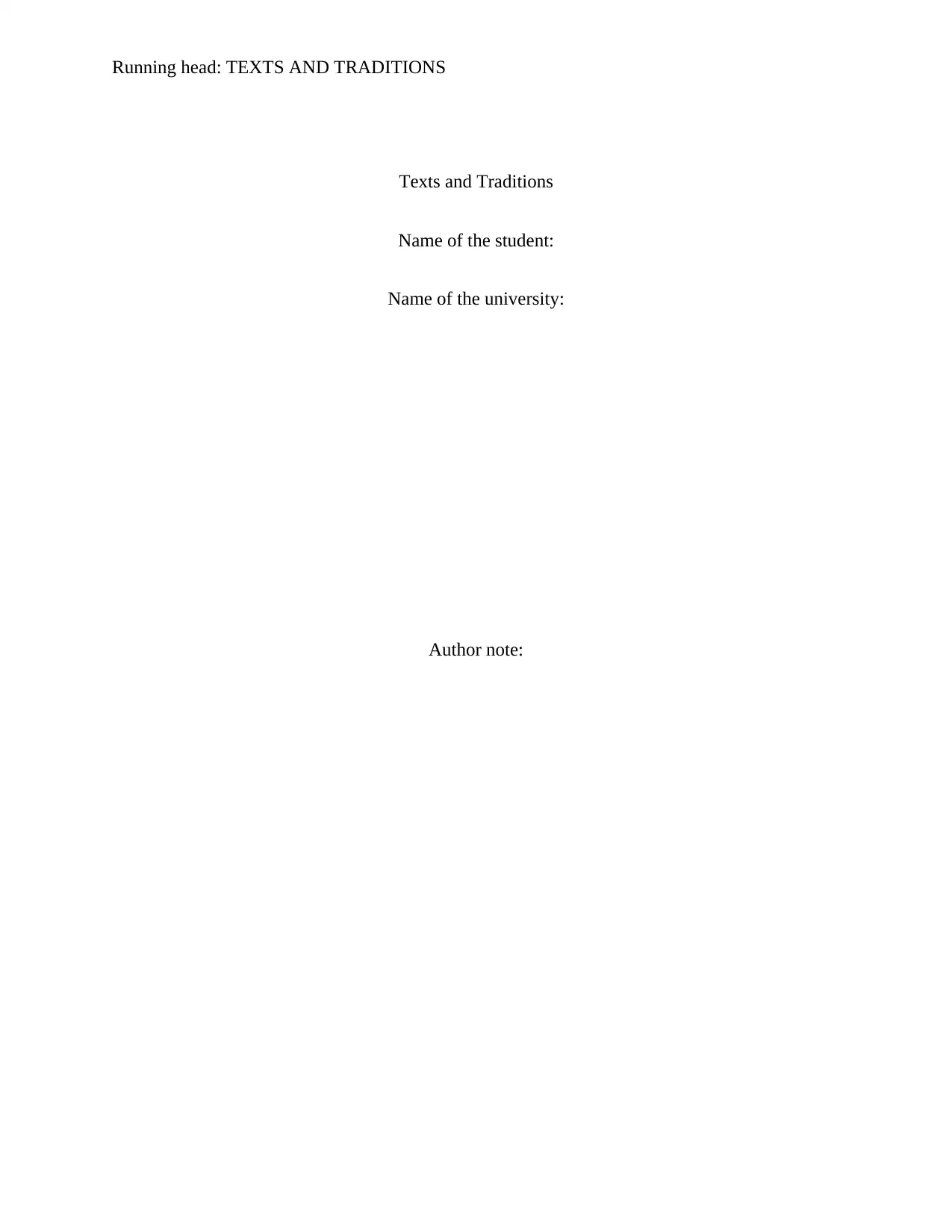
Running head: TEXTS AND TRADITIONS
Texts and Traditions
Name of the student:
Name of the university:
Author note:
Texts and Traditions
Name of the student:
Name of the university:
Author note:
Paraphrase This Document
Need a fresh take? Get an instant paraphrase of this document with our AI Paraphraser
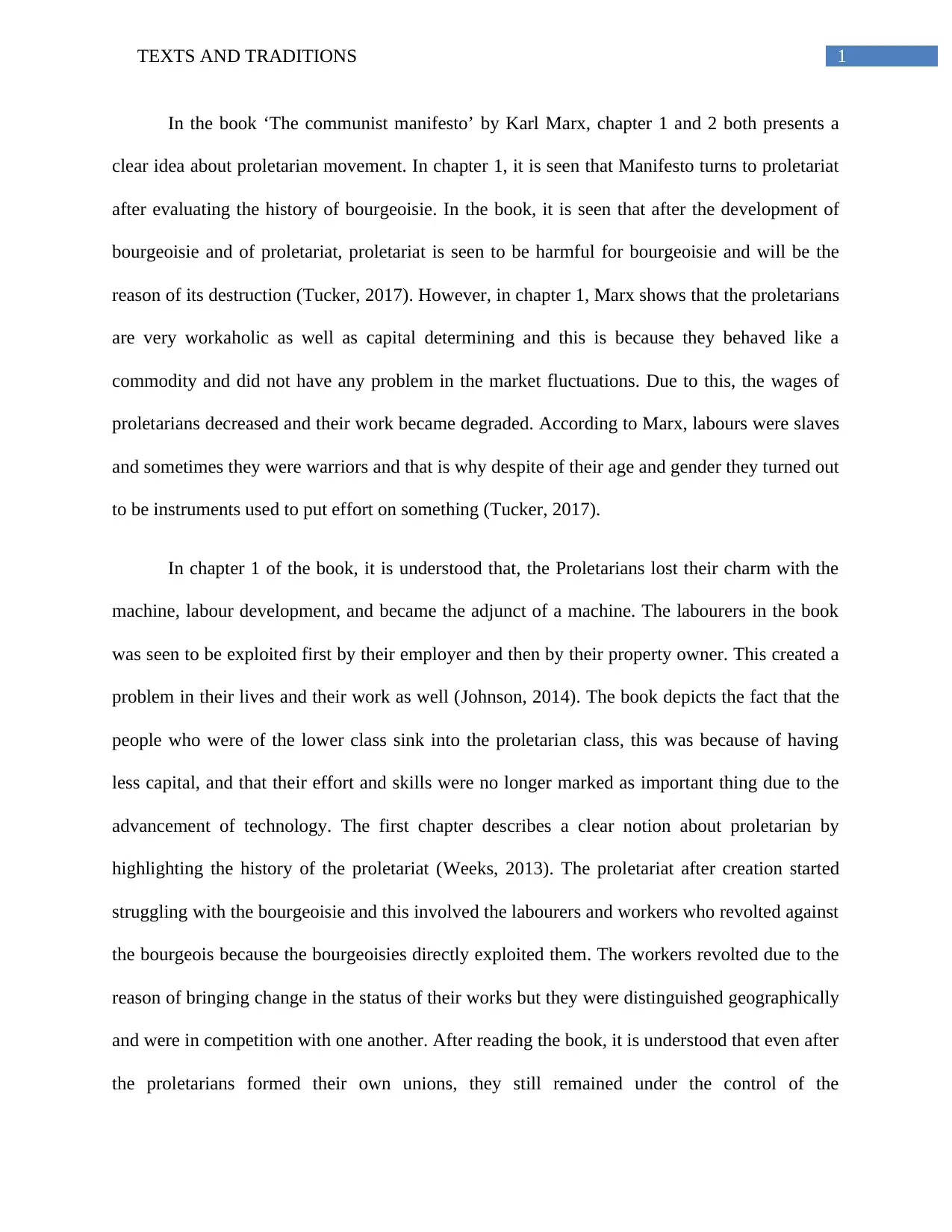
1TEXTS AND TRADITIONS
In the book ‘The communist manifesto’ by Karl Marx, chapter 1 and 2 both presents a
clear idea about proletarian movement. In chapter 1, it is seen that Manifesto turns to proletariat
after evaluating the history of bourgeoisie. In the book, it is seen that after the development of
bourgeoisie and of proletariat, proletariat is seen to be harmful for bourgeoisie and will be the
reason of its destruction (Tucker, 2017). However, in chapter 1, Marx shows that the proletarians
are very workaholic as well as capital determining and this is because they behaved like a
commodity and did not have any problem in the market fluctuations. Due to this, the wages of
proletarians decreased and their work became degraded. According to Marx, labours were slaves
and sometimes they were warriors and that is why despite of their age and gender they turned out
to be instruments used to put effort on something (Tucker, 2017).
In chapter 1 of the book, it is understood that, the Proletarians lost their charm with the
machine, labour development, and became the adjunct of a machine. The labourers in the book
was seen to be exploited first by their employer and then by their property owner. This created a
problem in their lives and their work as well (Johnson, 2014). The book depicts the fact that the
people who were of the lower class sink into the proletarian class, this was because of having
less capital, and that their effort and skills were no longer marked as important thing due to the
advancement of technology. The first chapter describes a clear notion about proletarian by
highlighting the history of the proletariat (Weeks, 2013). The proletariat after creation started
struggling with the bourgeoisie and this involved the labourers and workers who revolted against
the bourgeois because the bourgeoisies directly exploited them. The workers revolted due to the
reason of bringing change in the status of their works but they were distinguished geographically
and were in competition with one another. After reading the book, it is understood that even after
the proletarians formed their own unions, they still remained under the control of the
In the book ‘The communist manifesto’ by Karl Marx, chapter 1 and 2 both presents a
clear idea about proletarian movement. In chapter 1, it is seen that Manifesto turns to proletariat
after evaluating the history of bourgeoisie. In the book, it is seen that after the development of
bourgeoisie and of proletariat, proletariat is seen to be harmful for bourgeoisie and will be the
reason of its destruction (Tucker, 2017). However, in chapter 1, Marx shows that the proletarians
are very workaholic as well as capital determining and this is because they behaved like a
commodity and did not have any problem in the market fluctuations. Due to this, the wages of
proletarians decreased and their work became degraded. According to Marx, labours were slaves
and sometimes they were warriors and that is why despite of their age and gender they turned out
to be instruments used to put effort on something (Tucker, 2017).
In chapter 1 of the book, it is understood that, the Proletarians lost their charm with the
machine, labour development, and became the adjunct of a machine. The labourers in the book
was seen to be exploited first by their employer and then by their property owner. This created a
problem in their lives and their work as well (Johnson, 2014). The book depicts the fact that the
people who were of the lower class sink into the proletarian class, this was because of having
less capital, and that their effort and skills were no longer marked as important thing due to the
advancement of technology. The first chapter describes a clear notion about proletarian by
highlighting the history of the proletariat (Weeks, 2013). The proletariat after creation started
struggling with the bourgeoisie and this involved the labourers and workers who revolted against
the bourgeois because the bourgeoisies directly exploited them. The workers revolted due to the
reason of bringing change in the status of their works but they were distinguished geographically
and were in competition with one another. After reading the book, it is understood that even after
the proletarians formed their own unions, they still remained under the control of the
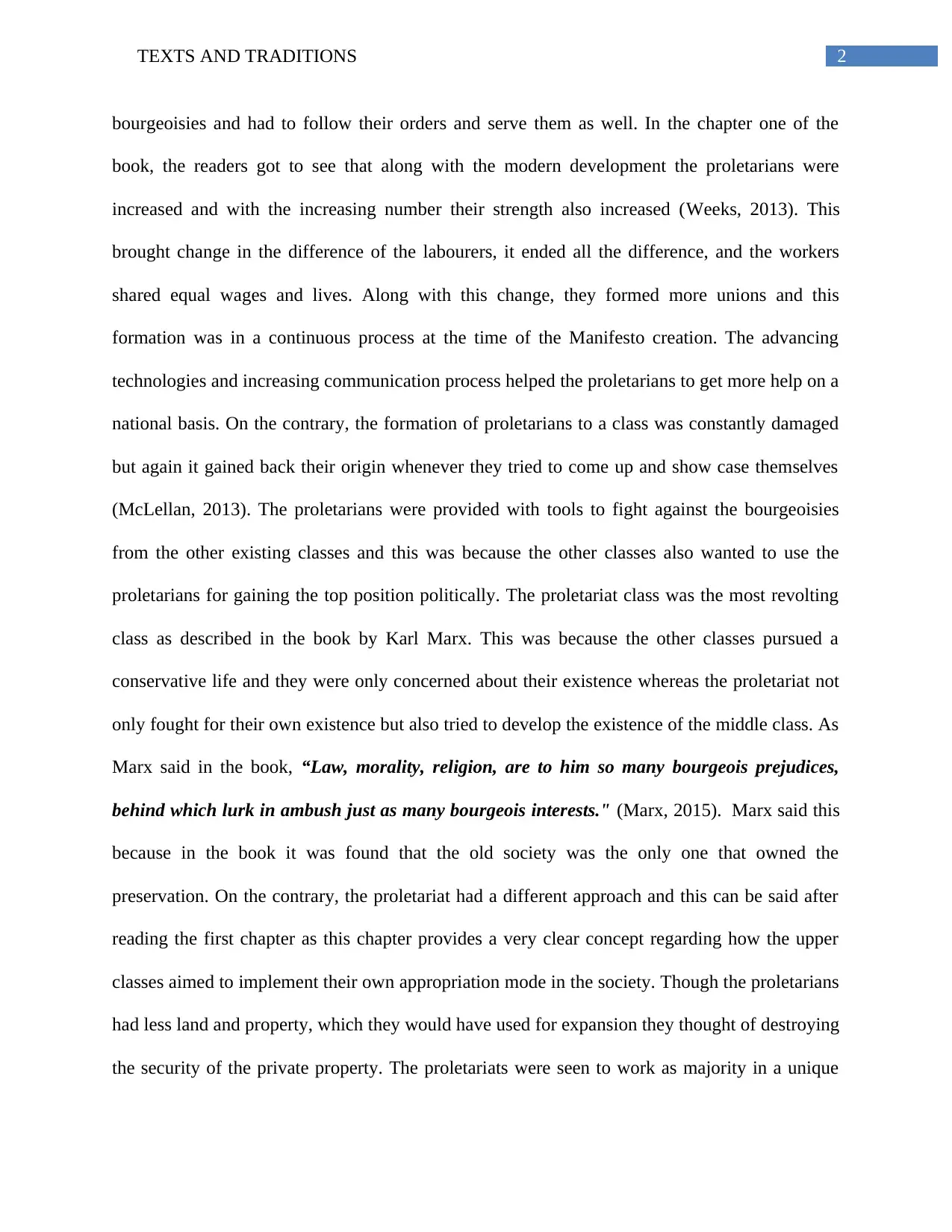
2TEXTS AND TRADITIONS
bourgeoisies and had to follow their orders and serve them as well. In the chapter one of the
book, the readers got to see that along with the modern development the proletarians were
increased and with the increasing number their strength also increased (Weeks, 2013). This
brought change in the difference of the labourers, it ended all the difference, and the workers
shared equal wages and lives. Along with this change, they formed more unions and this
formation was in a continuous process at the time of the Manifesto creation. The advancing
technologies and increasing communication process helped the proletarians to get more help on a
national basis. On the contrary, the formation of proletarians to a class was constantly damaged
but again it gained back their origin whenever they tried to come up and show case themselves
(McLellan, 2013). The proletarians were provided with tools to fight against the bourgeoisies
from the other existing classes and this was because the other classes also wanted to use the
proletarians for gaining the top position politically. The proletariat class was the most revolting
class as described in the book by Karl Marx. This was because the other classes pursued a
conservative life and they were only concerned about their existence whereas the proletariat not
only fought for their own existence but also tried to develop the existence of the middle class. As
Marx said in the book, “Law, morality, religion, are to him so many bourgeois prejudices,
behind which lurk in ambush just as many bourgeois interests." (Marx, 2015). Marx said this
because in the book it was found that the old society was the only one that owned the
preservation. On the contrary, the proletariat had a different approach and this can be said after
reading the first chapter as this chapter provides a very clear concept regarding how the upper
classes aimed to implement their own appropriation mode in the society. Though the proletarians
had less land and property, which they would have used for expansion they thought of destroying
the security of the private property. The proletariats were seen to work as majority in a unique
bourgeoisies and had to follow their orders and serve them as well. In the chapter one of the
book, the readers got to see that along with the modern development the proletarians were
increased and with the increasing number their strength also increased (Weeks, 2013). This
brought change in the difference of the labourers, it ended all the difference, and the workers
shared equal wages and lives. Along with this change, they formed more unions and this
formation was in a continuous process at the time of the Manifesto creation. The advancing
technologies and increasing communication process helped the proletarians to get more help on a
national basis. On the contrary, the formation of proletarians to a class was constantly damaged
but again it gained back their origin whenever they tried to come up and show case themselves
(McLellan, 2013). The proletarians were provided with tools to fight against the bourgeoisies
from the other existing classes and this was because the other classes also wanted to use the
proletarians for gaining the top position politically. The proletariat class was the most revolting
class as described in the book by Karl Marx. This was because the other classes pursued a
conservative life and they were only concerned about their existence whereas the proletariat not
only fought for their own existence but also tried to develop the existence of the middle class. As
Marx said in the book, “Law, morality, religion, are to him so many bourgeois prejudices,
behind which lurk in ambush just as many bourgeois interests." (Marx, 2015). Marx said this
because in the book it was found that the old society was the only one that owned the
preservation. On the contrary, the proletariat had a different approach and this can be said after
reading the first chapter as this chapter provides a very clear concept regarding how the upper
classes aimed to implement their own appropriation mode in the society. Though the proletarians
had less land and property, which they would have used for expansion they thought of destroying
the security of the private property. The proletariats were seen to work as majority in a unique
⊘ This is a preview!⊘
Do you want full access?
Subscribe today to unlock all pages.

Trusted by 1+ million students worldwide
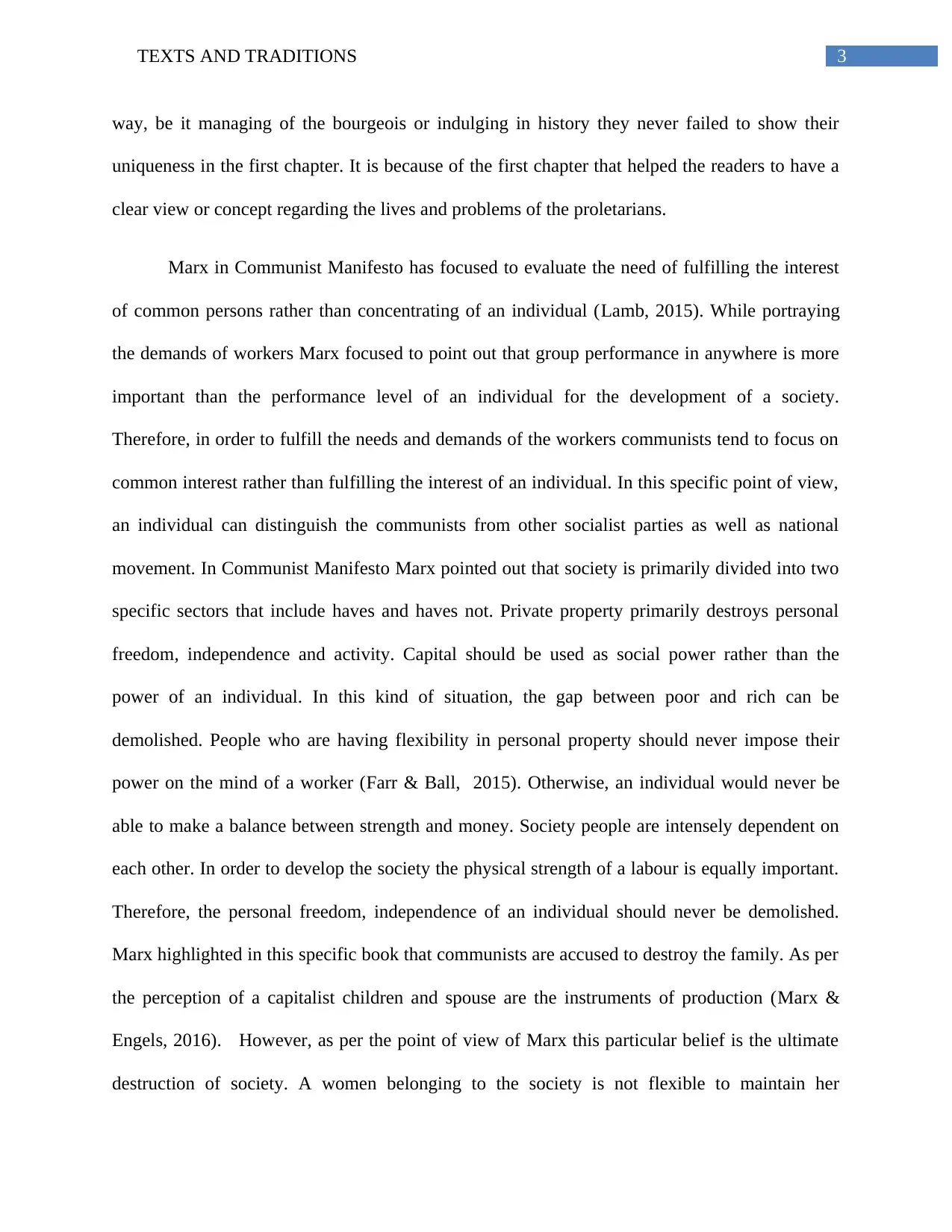
3TEXTS AND TRADITIONS
way, be it managing of the bourgeois or indulging in history they never failed to show their
uniqueness in the first chapter. It is because of the first chapter that helped the readers to have a
clear view or concept regarding the lives and problems of the proletarians.
Marx in Communist Manifesto has focused to evaluate the need of fulfilling the interest
of common persons rather than concentrating of an individual (Lamb, 2015). While portraying
the demands of workers Marx focused to point out that group performance in anywhere is more
important than the performance level of an individual for the development of a society.
Therefore, in order to fulfill the needs and demands of the workers communists tend to focus on
common interest rather than fulfilling the interest of an individual. In this specific point of view,
an individual can distinguish the communists from other socialist parties as well as national
movement. In Communist Manifesto Marx pointed out that society is primarily divided into two
specific sectors that include haves and haves not. Private property primarily destroys personal
freedom, independence and activity. Capital should be used as social power rather than the
power of an individual. In this kind of situation, the gap between poor and rich can be
demolished. People who are having flexibility in personal property should never impose their
power on the mind of a worker (Farr & Ball, 2015). Otherwise, an individual would never be
able to make a balance between strength and money. Society people are intensely dependent on
each other. In order to develop the society the physical strength of a labour is equally important.
Therefore, the personal freedom, independence of an individual should never be demolished.
Marx highlighted in this specific book that communists are accused to destroy the family. As per
the perception of a capitalist children and spouse are the instruments of production (Marx &
Engels, 2016). However, as per the point of view of Marx this particular belief is the ultimate
destruction of society. A women belonging to the society is not flexible to maintain her
way, be it managing of the bourgeois or indulging in history they never failed to show their
uniqueness in the first chapter. It is because of the first chapter that helped the readers to have a
clear view or concept regarding the lives and problems of the proletarians.
Marx in Communist Manifesto has focused to evaluate the need of fulfilling the interest
of common persons rather than concentrating of an individual (Lamb, 2015). While portraying
the demands of workers Marx focused to point out that group performance in anywhere is more
important than the performance level of an individual for the development of a society.
Therefore, in order to fulfill the needs and demands of the workers communists tend to focus on
common interest rather than fulfilling the interest of an individual. In this specific point of view,
an individual can distinguish the communists from other socialist parties as well as national
movement. In Communist Manifesto Marx pointed out that society is primarily divided into two
specific sectors that include haves and haves not. Private property primarily destroys personal
freedom, independence and activity. Capital should be used as social power rather than the
power of an individual. In this kind of situation, the gap between poor and rich can be
demolished. People who are having flexibility in personal property should never impose their
power on the mind of a worker (Farr & Ball, 2015). Otherwise, an individual would never be
able to make a balance between strength and money. Society people are intensely dependent on
each other. In order to develop the society the physical strength of a labour is equally important.
Therefore, the personal freedom, independence of an individual should never be demolished.
Marx highlighted in this specific book that communists are accused to destroy the family. As per
the perception of a capitalist children and spouse are the instruments of production (Marx &
Engels, 2016). However, as per the point of view of Marx this particular belief is the ultimate
destruction of society. A women belonging to the society is not flexible to maintain her
Paraphrase This Document
Need a fresh take? Get an instant paraphrase of this document with our AI Paraphraser
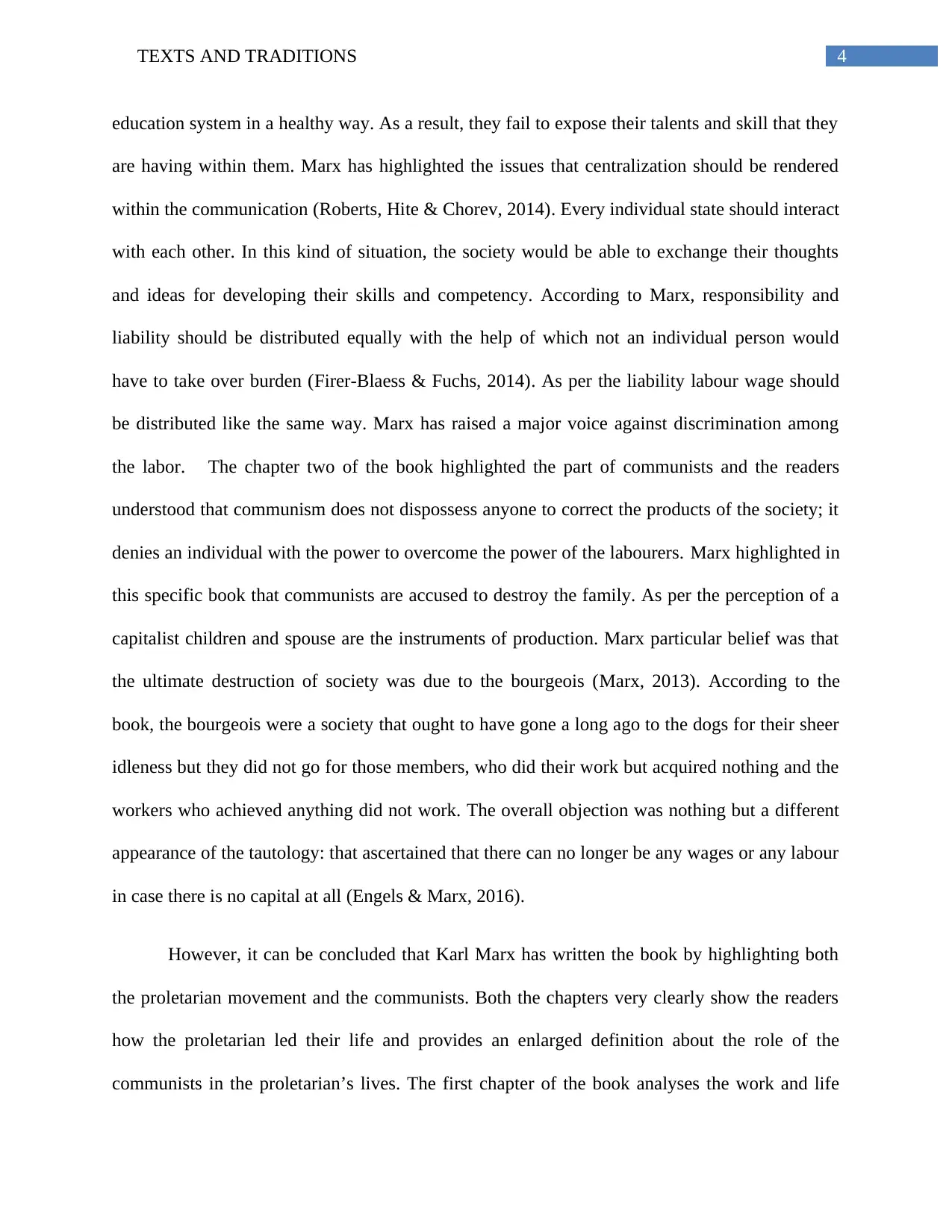
4TEXTS AND TRADITIONS
education system in a healthy way. As a result, they fail to expose their talents and skill that they
are having within them. Marx has highlighted the issues that centralization should be rendered
within the communication (Roberts, Hite & Chorev, 2014). Every individual state should interact
with each other. In this kind of situation, the society would be able to exchange their thoughts
and ideas for developing their skills and competency. According to Marx, responsibility and
liability should be distributed equally with the help of which not an individual person would
have to take over burden (Firer-Blaess & Fuchs, 2014). As per the liability labour wage should
be distributed like the same way. Marx has raised a major voice against discrimination among
the labor. The chapter two of the book highlighted the part of communists and the readers
understood that communism does not dispossess anyone to correct the products of the society; it
denies an individual with the power to overcome the power of the labourers. Marx highlighted in
this specific book that communists are accused to destroy the family. As per the perception of a
capitalist children and spouse are the instruments of production. Marx particular belief was that
the ultimate destruction of society was due to the bourgeois (Marx, 2013). According to the
book, the bourgeois were a society that ought to have gone a long ago to the dogs for their sheer
idleness but they did not go for those members, who did their work but acquired nothing and the
workers who achieved anything did not work. The overall objection was nothing but a different
appearance of the tautology: that ascertained that there can no longer be any wages or any labour
in case there is no capital at all (Engels & Marx, 2016).
However, it can be concluded that Karl Marx has written the book by highlighting both
the proletarian movement and the communists. Both the chapters very clearly show the readers
how the proletarian led their life and provides an enlarged definition about the role of the
communists in the proletarian’s lives. The first chapter of the book analyses the work and life
education system in a healthy way. As a result, they fail to expose their talents and skill that they
are having within them. Marx has highlighted the issues that centralization should be rendered
within the communication (Roberts, Hite & Chorev, 2014). Every individual state should interact
with each other. In this kind of situation, the society would be able to exchange their thoughts
and ideas for developing their skills and competency. According to Marx, responsibility and
liability should be distributed equally with the help of which not an individual person would
have to take over burden (Firer-Blaess & Fuchs, 2014). As per the liability labour wage should
be distributed like the same way. Marx has raised a major voice against discrimination among
the labor. The chapter two of the book highlighted the part of communists and the readers
understood that communism does not dispossess anyone to correct the products of the society; it
denies an individual with the power to overcome the power of the labourers. Marx highlighted in
this specific book that communists are accused to destroy the family. As per the perception of a
capitalist children and spouse are the instruments of production. Marx particular belief was that
the ultimate destruction of society was due to the bourgeois (Marx, 2013). According to the
book, the bourgeois were a society that ought to have gone a long ago to the dogs for their sheer
idleness but they did not go for those members, who did their work but acquired nothing and the
workers who achieved anything did not work. The overall objection was nothing but a different
appearance of the tautology: that ascertained that there can no longer be any wages or any labour
in case there is no capital at all (Engels & Marx, 2016).
However, it can be concluded that Karl Marx has written the book by highlighting both
the proletarian movement and the communists. Both the chapters very clearly show the readers
how the proletarian led their life and provides an enlarged definition about the role of the
communists in the proletarian’s lives. The first chapter of the book analyses the work and life
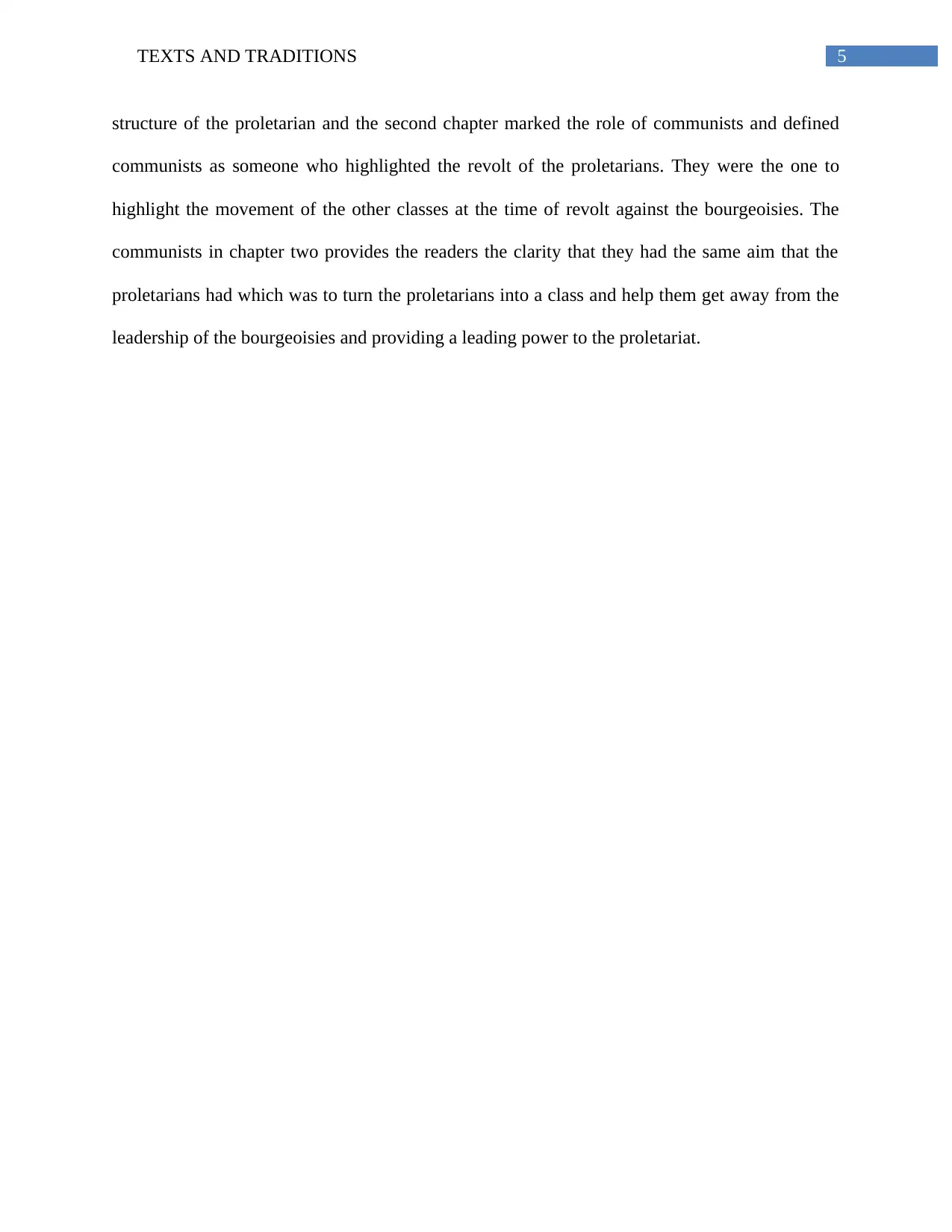
5TEXTS AND TRADITIONS
structure of the proletarian and the second chapter marked the role of communists and defined
communists as someone who highlighted the revolt of the proletarians. They were the one to
highlight the movement of the other classes at the time of revolt against the bourgeoisies. The
communists in chapter two provides the readers the clarity that they had the same aim that the
proletarians had which was to turn the proletarians into a class and help them get away from the
leadership of the bourgeoisies and providing a leading power to the proletariat.
structure of the proletarian and the second chapter marked the role of communists and defined
communists as someone who highlighted the revolt of the proletarians. They were the one to
highlight the movement of the other classes at the time of revolt against the bourgeoisies. The
communists in chapter two provides the readers the clarity that they had the same aim that the
proletarians had which was to turn the proletarians into a class and help them get away from the
leadership of the bourgeoisies and providing a leading power to the proletariat.
⊘ This is a preview!⊘
Do you want full access?
Subscribe today to unlock all pages.

Trusted by 1+ million students worldwide
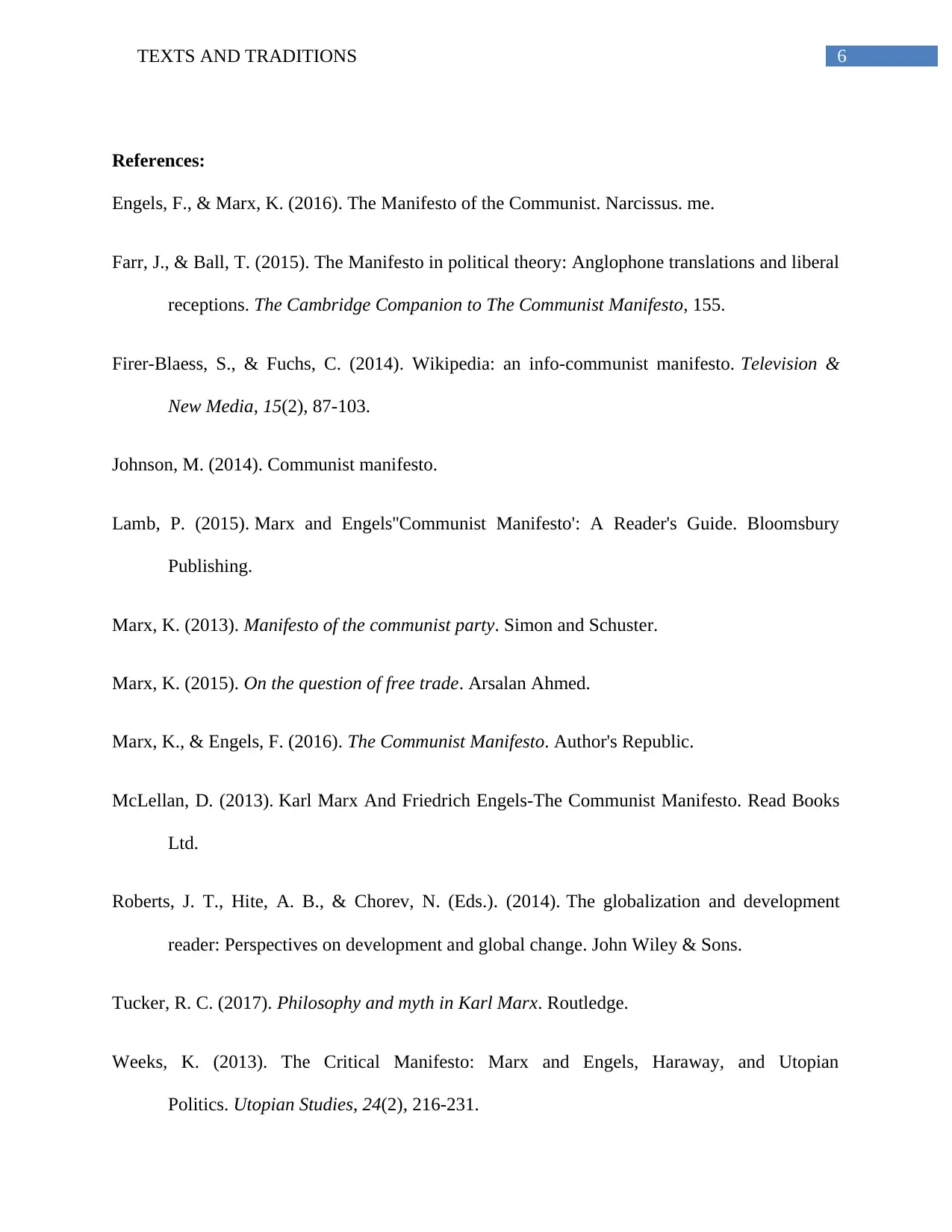
6TEXTS AND TRADITIONS
References:
Engels, F., & Marx, K. (2016). The Manifesto of the Communist. Narcissus. me.
Farr, J., & Ball, T. (2015). The Manifesto in political theory: Anglophone translations and liberal
receptions. The Cambridge Companion to The Communist Manifesto, 155.
Firer-Blaess, S., & Fuchs, C. (2014). Wikipedia: an info-communist manifesto. Television &
New Media, 15(2), 87-103.
Johnson, M. (2014). Communist manifesto.
Lamb, P. (2015). Marx and Engels''Communist Manifesto': A Reader's Guide. Bloomsbury
Publishing.
Marx, K. (2013). Manifesto of the communist party. Simon and Schuster.
Marx, K. (2015). On the question of free trade. Arsalan Ahmed.
Marx, K., & Engels, F. (2016). The Communist Manifesto. Author's Republic.
McLellan, D. (2013). Karl Marx And Friedrich Engels-The Communist Manifesto. Read Books
Ltd.
Roberts, J. T., Hite, A. B., & Chorev, N. (Eds.). (2014). The globalization and development
reader: Perspectives on development and global change. John Wiley & Sons.
Tucker, R. C. (2017). Philosophy and myth in Karl Marx. Routledge.
Weeks, K. (2013). The Critical Manifesto: Marx and Engels, Haraway, and Utopian
Politics. Utopian Studies, 24(2), 216-231.
References:
Engels, F., & Marx, K. (2016). The Manifesto of the Communist. Narcissus. me.
Farr, J., & Ball, T. (2015). The Manifesto in political theory: Anglophone translations and liberal
receptions. The Cambridge Companion to The Communist Manifesto, 155.
Firer-Blaess, S., & Fuchs, C. (2014). Wikipedia: an info-communist manifesto. Television &
New Media, 15(2), 87-103.
Johnson, M. (2014). Communist manifesto.
Lamb, P. (2015). Marx and Engels''Communist Manifesto': A Reader's Guide. Bloomsbury
Publishing.
Marx, K. (2013). Manifesto of the communist party. Simon and Schuster.
Marx, K. (2015). On the question of free trade. Arsalan Ahmed.
Marx, K., & Engels, F. (2016). The Communist Manifesto. Author's Republic.
McLellan, D. (2013). Karl Marx And Friedrich Engels-The Communist Manifesto. Read Books
Ltd.
Roberts, J. T., Hite, A. B., & Chorev, N. (Eds.). (2014). The globalization and development
reader: Perspectives on development and global change. John Wiley & Sons.
Tucker, R. C. (2017). Philosophy and myth in Karl Marx. Routledge.
Weeks, K. (2013). The Critical Manifesto: Marx and Engels, Haraway, and Utopian
Politics. Utopian Studies, 24(2), 216-231.
1 out of 7
Your All-in-One AI-Powered Toolkit for Academic Success.
+13062052269
info@desklib.com
Available 24*7 on WhatsApp / Email
![[object Object]](/_next/static/media/star-bottom.7253800d.svg)
Unlock your academic potential
Copyright © 2020–2025 A2Z Services. All Rights Reserved. Developed and managed by ZUCOL.
